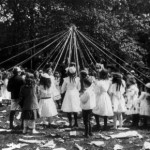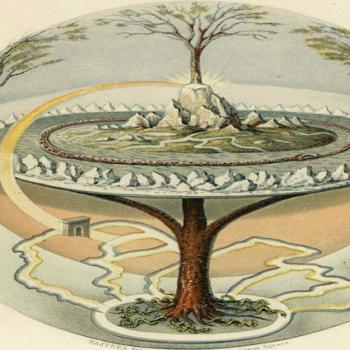 Over the past few months, following the publication of a piece by Gods & Radicals on the New Right and the modern Pagan and polytheistic movements, there has been a great deal of debate and uproar on the subject. Though there have been quite a few eschewing debate for personal attacks, ranging from a recent red-baiting post by John Michael Greer to others unworthy of mention, thankfully in spite of this there have been a number of thoughtful critiques and discussions of the subject. Authors such as River Devora, John Beckett, G.B. Marian, Craig ‘VI’ Slee, and many others have offered solid questions and points in this conversation. In my opinion if there is any major flaw in the work done by Gods & Radicals on this topic it is that further explanation of the particulars of how the New Right operates, not just the what used by them, is necessary. However, it is worth pointing out going into detail on these matters would have produced a small novel’s worth of material to read through and probably wouldn’t have been suitable for the intended platform.
Over the past few months, following the publication of a piece by Gods & Radicals on the New Right and the modern Pagan and polytheistic movements, there has been a great deal of debate and uproar on the subject. Though there have been quite a few eschewing debate for personal attacks, ranging from a recent red-baiting post by John Michael Greer to others unworthy of mention, thankfully in spite of this there have been a number of thoughtful critiques and discussions of the subject. Authors such as River Devora, John Beckett, G.B. Marian, Craig ‘VI’ Slee, and many others have offered solid questions and points in this conversation. In my opinion if there is any major flaw in the work done by Gods & Radicals on this topic it is that further explanation of the particulars of how the New Right operates, not just the what used by them, is necessary. However, it is worth pointing out going into detail on these matters would have produced a small novel’s worth of material to read through and probably wouldn’t have been suitable for the intended platform.
It is my hope, in the spirit of the other bloggers who have taken up this topic, to move this aspect of the discussion forward. I believe this element, critical to our understanding of the problem of the New Right, is one that needs further attention and care. There are two key aspects to this broader discussion that must be effectively addressed if we are to move ahead in understanding the problem of the New Right and modern Paganism. These are cultural factors and structural factors.
The first, which was covered in detail by Gods & Radicals, is the question of specific cultural factors that are used by New Right activists to twist spiritual groups into fronts for advancing their ideology. I want to make very clear the presence of particular cultural factors in specific groups or traditions does not inherently make them more or less likely to fall prey to New Right entryism. Before going into why these specific cultural elements must be discussed it is first necessary to understand what, exactly, entryism is.
Entryism, for those unfamiliar, is a specific strategy employed by political groups to advance their agendas. Entryism occurs when a member of such a group joins an organization or movement with the intent of covertly changing their goals, methods, and beliefs into those of the entryist group. Such tactics have become a favorite of the New Right over the past two decades for a very simple reason. The vast majority of human beings don’t like the idea of living under the heel of a jackboot. The fact that more conventional forms of fascist and neo-Nazi organizing ended in blood and death for their leaders is an equally crucial factor in causing this shift towards employing entryist tactics as advocated by New Right leaders such as so-called National Anarchist Troy Southgate, “race realist” David Duke, and mystical racialists like Michael Moynihan, David Lane and his partner Ron McVan, Jack Donovan, and Stephen McNallen.
Entryist tactics are not happening in a vacuum for the New Right. They are part of a broader strategy of what is referred to as engaging in metapolitics. Metapolitical action, in the world of the New Right, is where instead of engaging with political issues directly one focuses instead on changing the culture, preconceptions, and assumptions of a particular group and larger society to assumptions that are receptive to and best enable achieving the New Right’s goals. Some go so far as to describe metapolitical action as “occult warfare”, a term first coined by Michael Moynihan. An especially powerful weapon in this ideological arsenal is what is known as “apple pie words”, meaning the use of seemingly inoffensive terms like, “identity”, “tribalism”, and “cultural diversity” as a way of winning people over to New Right positions by actively misrepresenting them in terms the target audience is most likely to embrace without question.
To further lend legitimacy to their arguments New Right activists employ pseudoscientific language and discredited research in an attempt to portray their views as natural, justified, and representative of the human condition. A particular favorite is the discredited historian Oswald Spengler who, though a favorite of some of the Beatnik poets, is widely derided within the discipline due to his overly deterministic, race based assumptions regarding human history and culture. In spite of these factors his works are used because they lend a veneer of credibility to fascist arguments for a revitalization of decaying, decadent cultures suffering from the effects of “mongrelization”. The goal is to camouflage their ideology in seemingly inoffensive words until they are confident they have successfully ensnared their intended targets.
 This is why these cultural factors belong in any analysis of fascist entryism in the Pagan and polytheist communities. This is not to say, as I mentioned earlier, the presence of specific ideas, positions, or approaches automatically guarantee fascist corruption and takeover. Rather what is important to understand is that New Right activists will use the same language, same concepts, and same aesthetics as Pagans and polytheists in an attempt to blend in, win over the unwary, and ultimately turn otherwise decent groups into platforms for organized bigotry. These ideas are the terrain fascists seek to move through, blend into, and ultimately use for ambushing the unprepared.
This is why these cultural factors belong in any analysis of fascist entryism in the Pagan and polytheist communities. This is not to say, as I mentioned earlier, the presence of specific ideas, positions, or approaches automatically guarantee fascist corruption and takeover. Rather what is important to understand is that New Right activists will use the same language, same concepts, and same aesthetics as Pagans and polytheists in an attempt to blend in, win over the unwary, and ultimately turn otherwise decent groups into platforms for organized bigotry. These ideas are the terrain fascists seek to move through, blend into, and ultimately use for ambushing the unprepared.
This is not to say ideas such as appealing to the ideas of pre-Christian European peoples are inherently fascist or reactionary in and of themselves. Effective antidotes for entryist co-optation already exist that do not require surrendering any key components of polytheistic or Pagan practice. The examples of Reclaiming and Feri, both of whom have robust cultures of inclusion, dialog, and reframing core concepts in ways that are most applicable to people living in the here and now, demonstrate one can be Pagan and antifascist without any real conflict between the two or surrender of core values. By better understanding what it is we believe, why, and most importantly how we should move in the present based on such ideas we can build practices, communities, and approaches which are thoroughly inoculated against fascist deception.
As Pagans and polytheists we must be constantly asking ourselves whether what we are doing is beneficial for people, life, and all practitioners in the present while honoring the spirit of what it is we seek to do. When one thoroughly examines Pagan and polytheist ideas there is no contradiction between building inclusive tribalism, honoring ancestral practice, or engaging in nature centered worship and doing so in a fashion that is aware, resistant, and antifascist. This discussion has been ongoing in Heathenry for a number of years now with increasing success for those building inclusive practice that is ancestral, polytheistic, nature based, and surrenders nothing of our identity, community, or core beliefs to the New Right. Though Gods & Radicals did not broach the subject in the most tactful fashion possible nowhere did they say we must cease to be who we are. The experiences of grassroots Heathenry, Reclaiming, and Feri show we can build cultures where the New Right has no soil for sowing their noxious seeds without compromising our identity or authenticity.
The second, which is covered somewhat by Gods & Radicals and sadly has escaped deeper discussion, is the question of structural factors. The presence or lack of specific cultural factors in enabling New Right takeovers of groups do not operate in a vacuum. Even if there are elements in a specific community, organization, or group New Rightists could use as cover and justification for their rhetoric these alone are not sufficient to enable total conquest. There are two main structural environments where this is possible. The first are highly authoritarian, hierarchical settings with little to no real accountability for those in positions of power. The other major structural avenue for fascist co-optation is when a sufficient critical mass of otherwise liberal, tolerant individuals and groups feel cooperating with the New Right is the most effective means of securing their own positions, influence, and respectability.
In discussing hierarchical, authoritarian groups I want to stress that the presence of hierarchy alone does not mean authoritarianism is at work or that New Rightist entryism is a guaranteed outcome. Truly authoritarian environments depend on situations where the power to make decisions and set the agenda is heavily concentrated in a small number of hands and there is little to no means for the rank and file membership to hold the powerful accountable. An excellent guide for determining the presence of such structures was written years ago by the late Isaac Bonewits and is readily available online. His ABCDEF matrix is an excellent system for analyzing how stratified groups, organizations, and communities are and where decision making power is concentrated.
The other major structural problem, namely the presence of otherwise tolerant individuals who feel their interests are better served through cooperating with or refraining from challenging the New Right, is a far more complex situation. For those who are swift to claim even raising this problem is a veiled attempt at inciting a witch hunt history offers two powerful rebuttals with the actual facts of Mussolini and Hitler’s rise to power. Mussolini was swept into power not due to his infamous March on Rome but thanks to deals he struck with powerful conservative politicians and the last minute refusal by the King of Italy to use force against the already faltering and vulnerable Blackshirts.[1] Hitler, for his part, became Chancellor thanks to the internal rivalries between conservative German politicians.[2] Prior to von Papen’s “backstairs conspiracy” that put Hitler in the Chancellor’s office the Nazi Party’s finances were crumbling and they were losing critical public support.[3]
The recent history of Heathenry, in spite of great strides being made in effective resistance to the New Right, gives a more direct and potent example. Nearly all of the active opposition to neofascist impulses within Heathenry in the United States and Canada has come from grassroots organizations, local kindreds, and communities who are refusing to allow the New Right to advance unopposed. The one institution many would expect to be leading this fight, the Troth, has not only refused to do so but has seen their Steer openly denounce such efforts earlier this year. Their governing board has taken no action regarding this statement and even more distressingly there is nothing in the Troth bylaws prohibiting Troth members from also being members of racist, fascist groups such as the AFA, the Soldiers of Odin, or the Hammerskins. Now I want to be clear I am not claiming the Troth itself, its leadership, or its members are in any way racist or fascist. I am only pointing out their leadership isn’t doing terribly much to oppose such influences and seem to be more comfortable working with the devil they know than they’ll publicly admit.
The best solutions to these structural problems are quite simple. Communities founded on accountability, transparent and participatory decision making processes, and who take strong, unapologetic stands for inclusivity, hospitality, and diversity are communities where the New Right has little influence or means for gaining ground. Again Reclaiming and Feri are both living proof this approach works as are the elements of modern Heathenry who are actively taking a stand against the New Right and for inclusive, hospitable practice. All of this can be done without surrendering the Gods, sacred mysteries, mysticism, or any of the other core tenets of modern Pagan and polytheistic practice.
In conclusion only by having robust discussion and dialog, confronting our assumptions, and being willing to challenge them in a constructive, open fashion can we build a community that is effectively immune to the New Right’s work. Before us is the question of whether Paganism and polytheism will be hollowed out by an odious ideology where the Gods and all that is holy are reduced to mere trappings for justifying power over others at all costs or if we will flourish and grow on our own merits leaving such beliefs, ideas, and people behind. Around the world a hydra of New Right groups are seeking to impose their ideologies on their communities and society at large by any means necessary. If we, as a movement, are to effectively resist these attempts we must understand them, be prepared to meet them, and repel them decisively wherever they rear their heads.
[1] Paxton, Robert O. The Anatomy of Fascism. New York: Knopf, 2004, 89-90
[2] Paxton 95-96
[3] Paxton 95

















